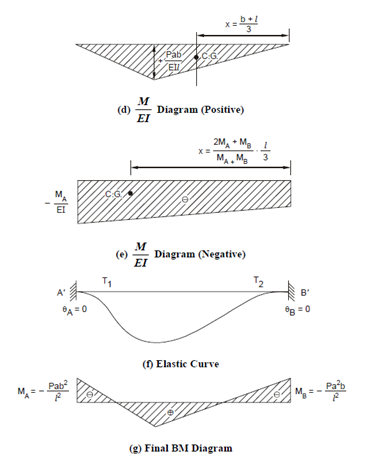Example of analysis of a fixed beam:
Now let us take the example of analysis of a fixed beam AB which carries a single concentrated load P at distance a and b from the ends A and B respectively (span l = a + b, and EI of the beam is constant).
Solution

The free BM diagram is shown in Figure 13(b). It is a triangle with maximum ordinate Pab / l at the point C (below the load).
Supposing the fixed end moments which are negative as - MA and - MB the fixed BM diagram is a trapezium as shown in Figure 13(c).
As EI is constant, the M/EI diagrams are similar and shown in Figures 13(d) and (e).
Now to search the unknown end moments A and B we have the following two conditions of compatibility:
(a) The modify of slope from A to B is zero since both the slopes are zero.
(b) A intercept of the tangents at A and B on a vertical line through B is zero since both the tangents are horizontal and at the same level.
Now, applying the moment area theorem to this condition:
(a) The first condition implies that the net area of the M/EI diagram from A to B is zero, i.e. area of positive M/EI diagram = area of negative M/EI diagram.
(b) The second condition provides that the net moment of the M/EI diagram about the vertical through B is zero which means the moment of area of positive M/EI diagram about B = moment of area of negative M/EI diagram about B.
The fields of the diagrams and their CG distances from B are shown in Figures 13(d) and (e) from which we get:
(a) Pas/2EI +((MA+MB)/2EI)I = 0
(b) (Pab/2EI) . (b+1/3) + ((MA+MB/2EI)l) . 2MA+MB/MA+MB .1/3 =0
that while simplified provides the following simultaneous equation
(M A + M B ) = - Pab/ l
And 2 M A + M B = - Pab (l + b)/l 2
Subtracting the first from the second
M A = - Pab2/l2
Substituting the value of MA in first equation above, we get
MB = -Pab/L -(-Pab2/L2)
=-Pabl/l2+Pab2/l2
=- Pab/l2(a+b-b)
=- Pa2b/l2
Here, because of their negative signs MA and MB are both hogging moments. But from the point of view of statics MA is an anticlockwise moment while MB is a clockwise moment as shown in the diagram.
Again by taking moments about B, we have
VA l - Pab2/l2 +Pa2b/l2 -Pb =0
giving VA =Pb/l +Pab/l3 (b-a)
and VB=Pa/l -Pab/l3 (b-a)
In Eq. (2.22), we clearly see that the first term in either case is the reactions of a simply supported beam; while the second term is caused due to the fixity of the supports. The sum of VA + VB remains equal to P for vertical equilibrium.
A maximum positive BM occurs below the load and is given by
MC = - MA +VA.a =2Pa2b2/l3.